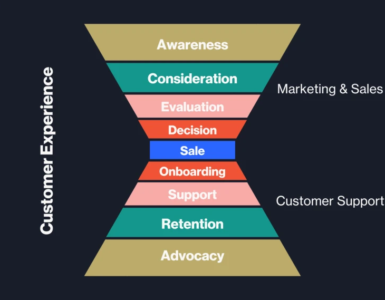In enterprise businesses’ complex and competitive landscape, a well-structured marketing department is pivotal for achieving sustainable growth and success. The sheer scale and diversity of operations in such organisations necessitate a strategic approach to marketing, and the organisational structure plays a key role in enabling this.
This blog post aims to delve into the intricacies of marketing department structures tailored for enterprise businesses. Drawing insights from the provided diagram and industry best practices, we will explore the key components, roles, and considerations involved in designing an effective marketing organisation that can navigate the complexities of the enterprise world.
The Foundation: Understanding the Organisational Chart
The provided diagram showcases a marketing department structure that aligns teams based on their core functions and areas of specialisation. Let’s break down the key elements:
- CMO (Chief Marketing Officer): At the helm of the structure is the CMO, the visionary leader responsible for setting the overall marketing strategy and ensuring its alignment with the company’s business objectives. The CMO oversees all marketing activities and drives brand awareness, customer acquisition, and revenue growth.
- Four Pillars: The structure branches into four primary divisions, each headed by a senior leader: Brand, Growth, Acquisition, and Media.
- Brand: This division focuses on building and maintaining a strong brand identity and reputation. It encompasses activities such as brand strategy, brand messaging, and brand campaigns.
- Growth: This division is tasked with driving sustainable growth through various channels. It may include growth marketing, partnerships, and customer lifecycle management.
- Acquisition: This division concentrates on acquiring new customers through various marketing channels and tactics. It may include teams focused on paid advertising, search engine optimisation (SEO), and lead generation.
- Media: This division manages the company’s media presence and communications. It may include teams handling public relations, media buying, and social media.
- Specialised Teams: Within each division are further specialised teams, each with a distinct focus and skill set. For instance, we see teams for Product Marketing and Creative under Brand. Under Acquisition, there are SEO, Website, and Conversion Rate Optimisation (CRO) teams.
- Individual Contributors: At the structure’s base are the individual contributors, the specialists who execute the day-to-day marketing activities. These roles include Graphic Designers, Social Media Managers, Content Creators, SEO Specialists, Web Developers, CRO Managers, Video Producers, and Podcast Producers.
- HubSpot & Content Analysts: While not explicitly placed within any division, these roles likely provide cross-functional support. HubSpot specialists manage the company’s marketing automation platform, and Content Analysts provide data-driven insights to inform marketing strategies.
Key Considerations for Enterprise Marketing Department Structures
Designing an effective marketing department structure requires careful consideration of various factors.
- Company Size and Complexity: The structure should be scalable and adaptable to the company’s size and complexity. Larger enterprises may require more specialised teams and hierarchical levels, while smaller ones may adopt a leaner structure with more cross-functional collaboration.
- Industry and Target Markets: Different industries and target markets have unique marketing needs and challenges. The structure should be tailored to address these specific requirements. For example, a B2B enterprise may need a stronger focus on account-based marketing, while a B2C enterprise might prioritise social media and influencer marketing.
- Marketing Strategy and Objectives: The structure should align with the company’s overall marketing strategy and objectives. If the focus is on brand building, the brand division may be more prominent. If the goal is rapid customer acquisition, the acquisition division may take centre stage.
- Talent and Resources: The structure should leverage the company’s existing talent and resources while also allowing for future growth and expansion. It is essential to have the right people in the right roles with clear responsibilities and accountability.
- Technology and Tools: The structure should also consider the marketing department’s technology and tools. Marketing automation platforms, CRM systems, and analytics tools can significantly impact team collaboration and efficiency.
Strategies for Optimising Marketing Department Performance
Once the structure is in place, it’s essential to implement strategies to optimise team performance and achieve marketing success.
- Clear Communication and Collaboration: Establish open communication channels and foster a culture of collaboration across teams and divisions. Regular meetings, cross-functional projects, and shared goals can help break down silos and promote synergy.
- Data-Driven Decision Making: Leverage data and analytics to inform marketing strategies and measure performance. Implement robust tracking and reporting mechanisms to gain insights into customer behaviour, campaign effectiveness, and ROI.
- Continuous Learning and Development: Invest in your marketing team’s ongoing training and development. Encourage them to stay abreast of the latest trends, technologies, and best practices in the industry.
- Agile and Adaptive Approach: The digital marketing landscape is constantly evolving. Foster an agile and adaptive mindset within the marketing department, enabling teams to respond quickly to market changes and emerging opportunities.
- Customer-Centric Focus: Place the customer at the heart of all marketing activities. Understand their needs, preferences, and pain points, and tailor your strategies and campaigns accordingly.
Conclusion
Designing an effective marketing department structure for an enterprise business is complex but crucial. By carefully considering your company’s unique needs, aligning the structure with your marketing strategy, and implementing strategies to optimise team performance, you can build a marketing department that drives growth, fosters innovation, and delivers exceptional customer experiences.





Add comment